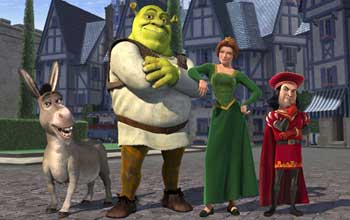
In part one of our candid discussion of animation, Ken mentioned the possibilities of co-production. Now we get a real insider's view of the way things might have been, the pulse of today, and what's in store for the future. But you also want to be able to work with the Japanese, too? KD: Yes, more creatively involved than what Sony is doing. Perhaps even from the writing stage. I know it could be done. For example, "Crouching Tiger, Hidden Dragon" had an American writer write with the Chinese writer and work with Ang Lee, the director. As far as I know, we haven't really seen anything like that before. It's always somebody wrote it and it was adapted to American [taste]. Never really had two writers working closely to make it work, and I think they did a pretty good job on it and there's no reason we can't do that on animation. I've done collaborations in the past. We had our writers here write a "Lupin" feature. We were pretty close to doing a co-production with Japan. They asked me to pitch a few properties that could work in both the Japanese market and the American market. I grew up with "Lupin" and I love "Lupin." There's a fairly good following of "Lupin" here in the United States and I'm sure if you ask some of the directors here and they'd say, "God, I'd love to direct it." So I got a couple of those guys and we flew to Japan and locked ourselves up in TMS for a week with their staff, we hashed out the story, we came back, our producer wrote a script. To make a long story short, we couldn't produce it obviously, but it was a start, and I learned from it. Next time we do something like that again, I'm confident that we can do something from a little different approach, but it think we had the right idea. We were in a conference room had a huge board and we hashed out ideas and people were drawing, "You mean like this?" We put them up in order and we took that back and our writer-producer sat down and wrote a script: "Lupin." Trying to keep the integrity of the original "Lupin," I sat down with Monkey Punch a little bit saying that this is what I want to do this is what I think and he was like, "Great!" Obviously he wanted to do it but it didn't work. That script is in permanent limbo? KD: Yeah, it was a co-production and we didn't hash out the money here, so it's with the Japanese company. Is there any chance that they'll just produce it? KD: I don't know. We'd have to see. But I know that if someone were interested, I wouldn't have any problem with trying to find the right talent to do that. And again, at that time, one of the big issues was we wanted to keep the integrity of the original "Lupin" that worked so well in Japan, but at the same time, there're certain areas that we have to work on so it'll be more appealing to the American audience. We were leaning toward a G audience, but it would have to be a little bit edgier than a G audience. In Japan when you look at the original "Lupin," the manga is very edgy. Then I think along the line when they started to produce for TV it kinda got a little... Miyazaki definitely made it family accessible (with "Castle of Cagliostro"). KD: Which works well. The TMS crew I was working with at the time was some of the guys that worked on the original series, so they knew Lupin inside out. One of the guys, his name was Mr. Otsuka, must be around 60, he's one of the animators that actually taught Miyazaki animation. He worked on "Cagliostro." We had a great team. They were teaching us what Lupin was all about.
If you had to comment on just the narrative aspect of animation, what do you feel is the one big narrative difference between Japanese storytelling and American storytelling? KD: Number one, the pacing is different. Sometimes Japanese animation is so slow. No disrespect to Studio I.G, but when I first saw "Ghost in the Shell," I was about to fall asleep. I mean, it's a great animation, it's wonderful, but there's a lot of talking and they go off in this tangent where you start to wonder, where is this going? I think the Japanese storytelling tends to get complicated. To me, they're overcomplicating something to a point where only the director knows what the story is. I still don't know what "Akira" is all about. I must've seen it ten times, and I'm like, what the hell is this story? I kinda get it but not really, you know? Like "2001: A Space Odyssey," it's a great film, but if you asked me to tell you in one paragraph what it's all about, I couldn't tell you. (Laugh) Would you say edgy directors like David Lynch and Stanley Kubrick here are animation directors in Japan? KD: I think there's definitely a similarity. When you look at most American animation they go for simplicity in terms of story telling. Why is that? In the States, I think it goes back to kids needing to be able to understand the story. Other wise forget it, don't even bother making it. But in Japan, that's not the case. Adults go see it, so it doesn't matter if the kids understand it. "Evangelion:" the hell was that supposed to be all about? I have no clue, but it's so well done. And I think it's the fact that these so called otaku and young adults might go, "I don't get it, but god, this is great!" Do you think that aspect of storytelling is going to change in American animation? KD: The studios and the networks have buyers right now, they're in their 30s and 40s and were brought up with Disney animation. You look at college kids, teenagers that are used to going out and playing videogames, that are used to watching anime, they will soon be in their 30s and 40s making the decisions for the network. That's when it's going to change. |
||||||||


